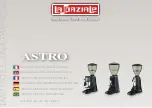
[7]
accessories will normally break apart
during this test time.
h)
Wear personal protective equipment.
Depending on application, use face
shield, safety goggles or safety glasses.
As appropriate, wear dust mask,
hearing
protectors,
gloves
and
workshop apron capable of stopping
small abrasive or workpiece fragments.
The eye protection must be capable of
stopping flying debris generated by
various operations. The dust mask or
respirator must be capable of filtrating
particles generated by your operation.
Prolonged exposure to high intensity
noise may cause hearing loss.
i)
Keep bystanders a safe distance away
from work area. Anyone entering the
work
area
must
wear
personal
protective equipment.
Fragments of
workpiece or of a broken accessory may
fly away and cause injury beyond
immediate are of operation.
j)
Hold power tool by insulated gripping
surfaces only, when performing an
operation where the cutting accessory
may contact hidden wiring.
Cutting
accessory contacting a “live” wire may
make exposed metal parts of the power
tool “live” and could give the operator
an electric shock.
k)
Position the cord clear of the spinning
accessory.
If you lose control, the cord
may be cut or snagged an your hand or
arm may be pulled into the spinning
accessory.
l)
Never lay the power tool down until the
accessory has come to a complete
pinning stop
. The spinning accessory
may grab the surface and pull the power
tool out of your control.
m)
Do not run the power tool while
carrying it at your side.
Accidental
contact with the spinning accessory
could snag your clothing pulling the
accessory into your body.
n)
Regularly clean the power tool’s air
vents.
The motor’s fan will draw the
dust inside the housing and excessive
accumulation of powdered metal may
cause electrical hazards.
o)
Do not operate the power tool near
flammable materials.
Sparks could
ignite these materials.
p)
Do not use accessories that require
liquid coolants.
Using water or other
liquid
coolants
may
result
in
electrocution or shock.
q)
Do not use Type 11 (flaring cup) wheels
on this tool.
Using inappropriate
accessories can result in injury.
r)
Always use side handle. Tighten the
handle securely.
The side handle should
always be used to maintain control of
the tool at all times.
s)
When starting the tool with new or
replacement wheel, or a new or
replacement wire brush installed, hold
the tool in a well-protected area and let
it run for one minute.
IF the wheel has
an undetected crack or flaw, it should
burst in less than one minute. If he wire
brush has loose wires, they will be
detected. Never start the tool with a
person in line with the wheel. This
includes the operator.
t)
Use of accessories not specified in the
manual is not recommended and may be
hazardous.
Use of power boosters that
would cause the tool to be driven at
speeds greater than its rated speed
constitutes misuse.
u)
Use clamps or another practical way to
secure and support the workpiece to a
stable platform.
Holding the work by
hand or against your body leaves it
unstable and may lead to loss of control.
v)
Avoid bouncing the wheel or giving it
rough treatment.
If this occurs, stop
the tool and inspect the wheel for
cracks or flaws.








































